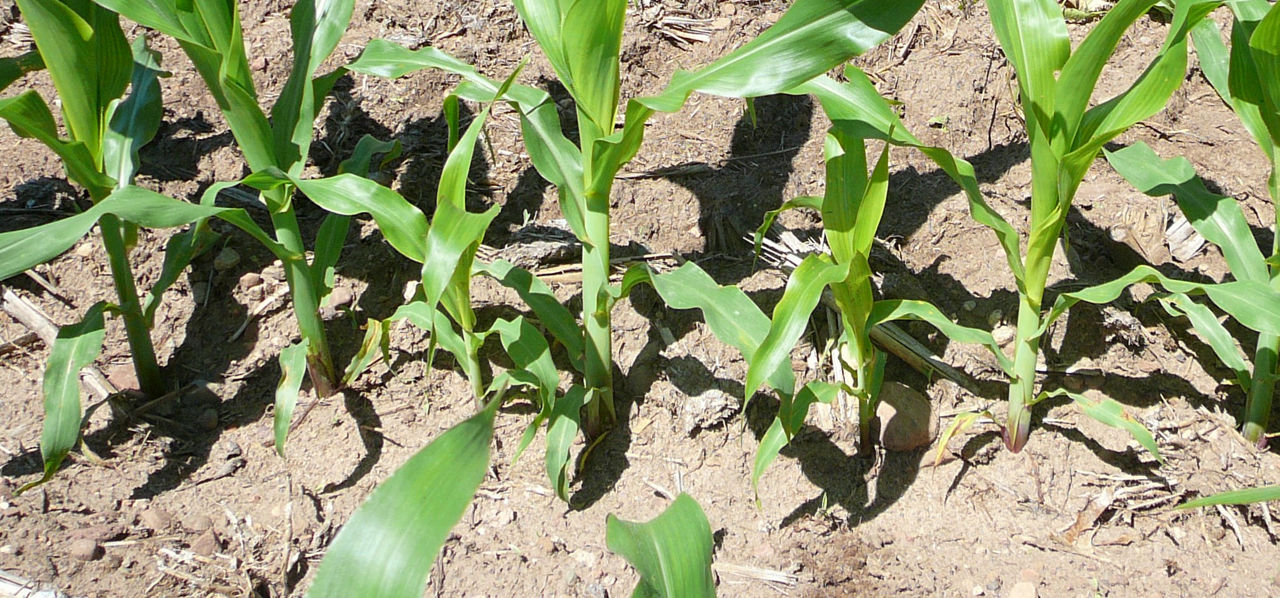Seed-to-soil contact. Corn kernels need to imbibe approximately 30% of their weight in water before germination begins. Lesser than optimum absorption of water may slow or stop the germination process.3 Soil must be firmed around the corn kernel to absorb moisture quickly and uniformly.2 Poor seed-to-seed contact can be caused by seed being in contact with residue, improper closure of the seed furrow, sidewall compaction, and cloddy soils; all of which may occur when soil is too wet.5
In addition to the above reasons; soil crusting, insect damage, herbicide injury, and disease may also cause uneven corn emergence and growth.
What is the impact on yield potential?
Uneven emergence can produce plants of differing growth stages and can reduce yield potential due to later emerging plants not producing a normal ear. The uneven corn stands can produce smaller stalks, smaller and fewer ears, and more barren reducing the yield potential. Uneven stands result in lower yields because the smaller, late-emerging plants cannot capture enough sunlight. In a Minnesota study, grain yield is reduced by about 20% for plants which are one-leaf stage behind earlier-emerged plants in the season, and by 50% for plants which are two-leaf stages behind.6
How can fields with uneven corn emergence be managed?
Wisconsin and Illinois researchers documented that however late-planting reduced yield and replanting would not increase yield potential unless more than half of the plants were delayed by three weeks or more. Replanting fields with variable emergence and corn plant heights rarely leads to an increase in yield potential Although yield potential is compromised in these fields, best decision is to leave the crop as such.7 To minimize the risk of uneven emergence, avoid working soils and/or planting when fields are too wet. Check periodically for uniform moisture and proper seed-to-soil contact during planting and adjust planter settings as necessary. When dealing with uneven stands throughout the growing season, it is important to use recommended herbicide application rates to avoid injuring corn. Be sure to apply herbicide based on the most advanced leaf stage in the field.5
Sources:
1 Harbach, C. 2014. Uneven corn emergence and yield potential. University of Illinois at Urbana-Champaign. https://extension.illinois.edu/blogs/hill-and-furrow/2014-05-19-uneven-corn-emergence-and-yield-potential.
2 Nielsen, R.L. 2010. Requirements for uniform germination and emergence of corn. Purdue University. https://ag.purdue.edu/agry/extension/Pages/default.aspx.
3 Nielsen, R.L. 2010. Visual indicators of germination in corn. Purdue University. https://www.agry.purdue.edu/ext/corn/news/timeless/GerminationEvents.html
4Licht, M. 2019. Imbibitional chilling or cold injury. Iowa State University, Extension and Outreach. https://crops.extension.iastate.edu/blog/mark-licht/imbibitional-chilling-or-cold-injury#:~:text=Imbibitional%20chilling%20occurs%20when%20there,the%20seed%20has%20imbibed%20water.
5 Carter, P.R., Nafziger, E. D., and Lauer, J. G. Uneven emergence in corn. North Central Regional Extension Pub. No. 344. http://corn.agronomy.wisc.edu/.
6Coulter, J. 2019. Key factors for evaluating corn stand establishment. https://blog-crop-news.extension.umn.edu/2019/05/key-factors-for-evaluating-corn-stand.html
7Elmore, R. and Abendroth, L. 2006. Yield effect of uneven corn heights. Iowa State University Agronomy Extension. https://crops.extension.iastate.edu/encyclopedia/whats-yield-effect-uneven-corn-heights.
3013_S2
